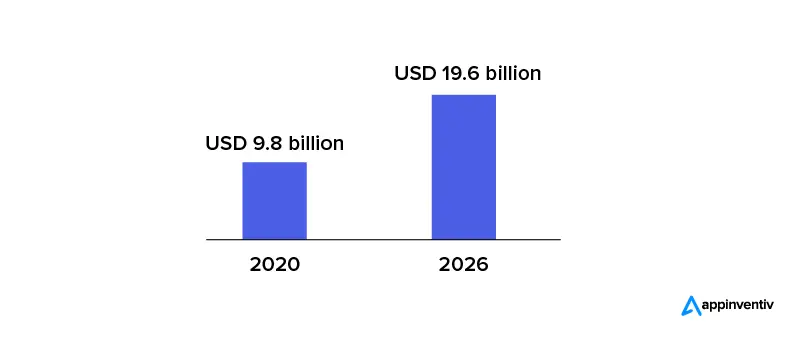To ensure employees don’t repeat tasks unnecessarily or abandon tasks before completion, overlook details, or don’t skip steps in workflows, businesses establish standardized processes. These business processes ensure compliance and conformity in how a company operates. Therefore, business processes need to stay consistent over repetitive executions. This is where business process automation (BPA) comes into play.
BPA focuses on automating day-to-day IT processes and business functions to maximize efficiency, reduce costs, and ensure smooth operations. As per a report by Markets and Markets, the global business process automation market size is expected to reach USD 19.6 billion by 2026 from USD 9.8 billion in 2020, growing at a CAGR of 12.2%.
Various factors such as enterprises planning to migrate their IT infrastructure to the cloud, boosting business continuity, and improving business operations have led to the wide adoption of BPA across the organizations.

In the following article, we will discuss the benefits of business process automation methodology along with the steps to implement automation in business processes.
But before we get into that, let’s first understand the differences between business process automation and robotic process automation to have more clarity on the concept.
So, without further ado, let’s dive in!
BPA vs RPA – What’s the difference?
Business process automation is often confused with robotic process automation, but both are distinct in their own ways. However, they do complement each other and can help you implement company-wide digital transformation seamlessly.
With robotic process automation, software users create software robots or bots that can learn, mimic, and then execute rules-based business processes. RPA automation enables users to create bots by observing human digital actions. Each bot is designed for a single specific task.
For example, a bot could be created to log into a system, copy data, and then paste that data into a spreadsheet.
BPA, on the other hand, is a holistic approach to optimize and automate business processes from start to finish. BPA is an end-to-end solution for automating entire business processes and RPA is a complement to a solid BPA approach. Additionally, BPA offers a range of capabilities not found in RPA. These include features that enhance collaboration and provide data and insights into process performance.
Now that we have looked into the key differences between RPA and BPA, let’s further understand how BPA is benefiting businesses and why it is an ideal approach when looking to automate manual processes.
Benefits of business process automation
In this section, we will be discussing the key advantages of automation in business and how it can improve the overall efficiency of your organization.

Reduced costs
When business processes are executed manually, a significant amount of resources are wasted and there is a higher chance of inefficiencies. As per a report, organizations lose 20-30% of their revenue every year due to inefficient processes. Switching from manual to automated processes allows for error minimization. That way, no time and money need to be spent on fixing issues. Also, resources are optimally utilized, and wastage is eliminated.
Generali, a leading European insurance provider, is one of the best business process automation examples. It shifted from paper-based processes that were costing them time and money to automated business processes. This reduced the time to underwrite complex tasks by half and savings of up to 90% through reusable processes.
Enhanced customer experience
One of the most exciting benefits of BPA is its positive impact on your customers, their experience with your business, and the way you serve them.
With BPA in place, you can respond to customers efficiently and faster, respecting your customers’ time and answering their requests and queries successfully at the same time.
What used to take several hours or even days, now only takes minutes. This, of course, can be applied to any number of customer interactions, including order processing.
This will improve your company’s reputation among your audience through positive word-of-mouth and stronger online reviews.
Improved operational efficiency
Implementing business process automation software brings about a host of operational benefits. To begin with, automated processes are largely hands-off, which means you don’t need to personally ensure that one task in the process is progressing to the next.
Additionally, business process automation also enables identifying and correcting errors and bottlenecks in workflows. This contributes to higher process efficiency overall.
For instance, Adidas implemented business process automation software to standardize its processes and automate various departments, including finance, marketing, eCommerce, and retail. The highly successful initiative reduced the time to market by two-thirds compared to the traditional in-house development and increased operational efficiency by 60%.
Visibility and transparency
With automation, the visibility of processes across the organization can be improved through customizable dashboards. Established key performance indicators (KPIs) can be easily tracked for multiple processes. In-depth reports of process performance can provide valuable insights into areas that need improvement.
Automation also facilitates transparency in business processes. This helps teams stay informed about tasks assigned and encourages accountability.
For instance, a global asset management company, Insight Investment wanted to document, discover, and digitize business processes to build transparency. By using customizable dashboards to visualize the data, they have created the foundation of a reporting system that reduces complexity, provides visibility to senior management, and makes handing off work more reliable.
Improved employee morale
A key advantage of business process automation methodology is higher employee morale. With automation, employees get friction-free to get the work done efficiently. Approvals are faster, which means teams don’t need to spend time waiting and reminding managers.
Transparency in processes helps high performers get the recognition they deserve. The bandwidth freed up by automation can motivate employees to innovate and improve the way work is done.
Now that we have understood what is business process automation, and gone through the major benefits along with business process automation examples, it’s time to dive into the key use cases of enterprise process automation.


